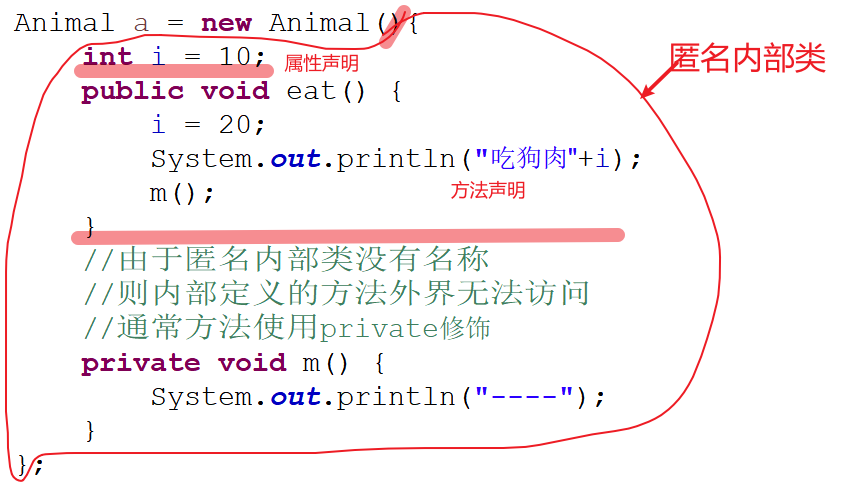08 - 面向对象程序设计(内部类)🎂
内部类
通常一个 java 文件中只能包含一个 public class,但是可以在一个 java 类的内部中嵌套其他的 java 类,这种类称之为内部类,也叫嵌套类,或者类属类,比如:
public class People {
public void m(){
}
public static void main(String[] args) {
}
//内部类
class Body{
}
}
//它不是内部类,它和People是平级的关系
//class Head{
//}
以上就是一个典型的内部类,生成的字节码文件如下:
People$Body.class People.class
java 中的内部类包含以下几种定义方式:
- 成员内部类
- 局部内部类
- 静态内部类
- 匿名内部类
内部类的好处
- 提供了比方法更好的封装性
- 提高类多继承的可能性
成员内部类
成员内部类即在类结构中直接定义的与属性,方法,构造器同一级别的类。
public class People extends JFrame{
public void m1() {
System.out.println("外部类方法");
// new Body().m3();
}
//内部类
private class Body extends ArrayList{
String name;
public void m2() {
System.out.println("内部类方法");
}
public void m3() {
}
}
}
成员内部类的使用场景:在 JDK 中有很多类使用到了成员内部类,例如: ArrayList:

成员内部类注意事项:
成员内部类类似成员方法,允许被任意的访问修饰符修饰(default,public,private,protected)
局部内部类
所谓局部内部类即在一个类的方法或者其他成员的(构造器,游离块)语句块中定义,不太常见:
public class User {
int n;
public void login() {
//jdk1.8之后无需显式定义final(编译器自动添加)
final int i = 10;
class Validate{
public void t() {
//成员变量在局部内部类中允许修改
n = 100;
//变量i在局部内部类只能使用不能修改
System.out.println("======="+i);
}
}
Validate v = new Validate();
v.t();
}
public void reg() {
//编译错误:找不到类
// Validate v = new Validate();
// v.t();
}
public static void main(String[] args) {
User u = new User();
u.login();
}
}
局部内部类注意事项:
- 不能使用任何的访问修饰符(除了 default 外)修饰,原理参考局部变量的定义
- 局部内部类中不能对方法中的局部变量进行修改,如果局部内部类中需要使用为外部方法的局部变量时,该变量必须定义为 final(java8 无需显式定义 final,编译器默认添加)
- 使用 final 修饰局部变量的作用在于延长局部变量的生命周期,避免因为方法的结束而被清理(可能局部内部类在使用该变量)
静态内部类
静态内部类即使用 static 修饰的成员内部类;静态内部类与外部类的对象无关,一般用于数据缓存,比如 Integer 中的静态内部类:IntegerCache
/**
* Cache to support the object identity semantics of autoboxing for values between
* -128 and 127 (inclusive) as required by JLS.
*
* The cache is initialized on first usage. The size of the cache
* may be controlled by the {@code -XX:AutoBoxCacheMax=<size>} option.
* During VM initialization, java.lang.Integer.IntegerCache.high property
* may be set and saved in the private system properties in the
* sun.misc.VM class.
*/
private static class IntegerCache {
static final int low = -128;
static final int high;
static final Integer cache[];
static {
// high value may be configured by property
int h = 127;
String integerCacheHighPropValue =
sun.misc.VM.getSavedProperty("java.lang.Integer.IntegerCache.high");
if (integerCacheHighPropValue != null) {
try {
int i = parseInt(integerCacheHighPropValue);
i = Math.max(i, 127);
// Maximum array size is Integer.MAX_VALUE
h = Math.min(i, Integer.MAX_VALUE - (-low) -1);
} catch( NumberFormatException nfe) {
// If the property cannot be parsed into an int, ignore it.
}
}
high = h;
cache = new Integer[(high - low) + 1];
int j = low;
for(int k = 0; k < cache.length; k++)
cache[k] = new Integer(j++);
// range [-128, 127] must be interned (JLS7 5.1.7)
assert IntegerCache.high >= 127;
}
private IntegerCache() {}
}
自定义静态内部类:
public class StaticClass {
public void m() {
System.out.println("外部类方法");
}
public static class MyCache{
static String msg = "天干物燥,小心火烛";
public static void t() {
System.out.println("静态内部类的方法");
}
public void m2() {
System.out.println("静态内部类的普通方法");
}
}
}
静态内部类的对象创建与方法调用:
//创建静态内部类的对象
StaticClass.MyCache cache = new StaticClass.MyCache();
//调用静态内部类的静态方法
StaticClass.MyCache.t();
//调用静态内部类的成员方法
cache.m2();
匿名内部类
匿名内部类即没有名字的内部类,通常用于事件监听机制,回调机制中
public abstract class Animal {
public abstract void eat();
}
匿名内部类实例:
public static void main(String[] args) {
//匿名内部类
Animal a = new Animal(){
int i = 10;
public void eat() {
i = 20;
System.out.println("吃狗肉"+i);
m();
}
//由于匿名内部类没有名称
//则内部定义的方法外界无法访问
//通常方法使用private修饰
private void m() {
System.out.println("----");
}
};
a.eat();
}

接口的匿名内部类使用
接口的声明:
public interface Flyable {
void fly();
}
接口匿名内部类使用:
Flyable f = new Flyable() {
public void fly() {
System.out.println("fly。。。。");
}
};
f.fly();
Timer&TimerTask
Timer 类是 JDK 中,java.util 包中提供的用于执行定时任务的定时器类;Timer 通常与 TimerTask 结合使用,以达到定时任务执行的功能,比如定时消息推送,闹钟应用的实现等。
TimerTask 是一个抽象类,内部的 run 方法是一个抽象方法,因此通过对 TimerTask 扩展可以创建自定义的定时任务,只需要实现 run 方法即可:
定时任务类:
public class MyTask extends TimerTask{
@Override
public void run() {
System.out.println("任务执行。。。");
}
}
测试类:
public class TestTimer {
public static void main(String[] args) {
//1秒 = 1000毫秒
//创建一个定时器
Timer t = new Timer();
//多态
t.schedule(new MyTask(), 5000,1000);
}
}
另外如果定时任务只在某个固定的位置使用,可以无需创建具体类进行继承;此时可以考虑使用匿名内部类实现:
Timer t = new Timer();
t.schedule(new TimerTask() {
public void run() {
System.out.println(LocalDateTime.now());
}
}, 3000, 500);
以上代码表示等待 3 秒执行任务,之后每隔 0.5 秒执行一次